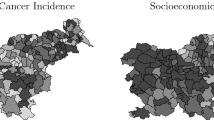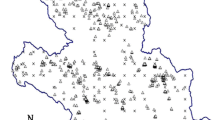Abstract
We present a comprehensive review of multivariate geostatistical models, focusing on the bivariate case. We compare in detail three approaches, the linear model of coregionalisation, the common component model and the kernel convolution approach, and discuss similarities between them. We demonstrate the merits of the common component class of models as a flexible means for modelling bivariate geostatistical data of the type that frequently arises in environmental applications. In particular, we show how kernel convolution can be used to approximate the common component model, and demonstrate the method using a data-set of calcium and magnesium concentrations in soil samples. We then apply the model to a study of domestic radon concentrations in the city of Winnipeg, Canada, in which exposure was measured at two sites (bedroom and basement) in each residential location. Our analysis demonstrates that in this study the correlation between the two sites within each house dominates the short-range spatial correlation typical of the distribution of radon.
Similar content being viewed by others
References
Banerjee S, Gelfand A, Finley A, Sang H (2008) Gaussian predictive process models for large spatial data sets. J Roy Stat Soc B 70: 825–848
Bárdossy A (2006) Copula-based geostatistical models for groundwater quality parameters. Water Resour Res 42: w11416. doi:10.1029/2005WR004754
Bárdossy A, Li J (2008) Geostatistical interpolation using copulas. Water Resour Res 44:w07412. doi:10.1029/2007WR006115
Barry R, Ver Hoef J (1996) Blackbox kriging: spatial prediction without specifying variogram models. J Agric Biol Environ Stat 1: 297–322
Berliner L (2000) Hierarchical Bayesian modeling in the environmental sciences. Allgemeines Statistische Archiv 84: 141–153
Boyle P, Frean M (2005) Multiple output Gaussian process regression. Tech. rep., School of Mathematical and Computing Sciences, Victoria University of Wellington
Brabec M, Jílek K (2009) Dynamical model for indoor radon concentration monitoring. Environmetrics 20: 718–729
Calder C (2007) Dynamic factor process convolution models for multivariate space-time data with application to air quality assessment. Environ Ecol Stat 14: 229–247
Calder C (2008) A dynamic process convolution approach to modeling ambient particulate matter concentrations. Environmetrics 19: 39–48
Calder C, Cressie N (2007) Some topics in convolution-based spatial modeling. In: Proceedings of the 56th session of the international statistics institute, Lisbon, Portugal
Calder C, Craigmile P, Zhang J (2009) Regional spatial modelling of topsoil geochemistry. Biometrics 65: 206–215
Chilès JP, Delfiner P (1999) Geostatistics: modeling spatial uncertainty. Wiley, New York
Cressie N (1993) Statistics for spatial data. Wiley, New York
Cressie N, Wikle C (1998) The variance-based cross-variogram: you can add apples and oranges. Math Geol 30: 789–799
D’Agostino V, Greene E, Passarella G, Vurro M (1993) Spatial and temporal study of nitrate concentration in groundwater by means of coregionalization. Environ Geol 36: 285–295
Diggle P, Ribeiro Jr P (2007) Model-based geostatistics. Springer, New York
Frees E, Valdez E (1998) Understanding relationships using copulas. North Am Actuar J 2: 1–25
Fuentes M (2001) A high frequency kriging approach for nonstationary environmental processes. Environmetrics 12: 469–483
Fuentes M (2002) Interpolation of nonstationary air pollution processes: a spatial spectral approach. Stat Modell 2: 281–298
Fuentes M (2002) Spectral methods for nonstationary spatial processes. Biometrika 89: 197–210
Gelfand A, Schmidt A, Sirmans C (2003) Multivariate spatial process models: conditional and unconditional Bayesian approaches using coregionalization. Tech. rep., Institute of Statistics and Decision Sciences, Duke University
Goovaerts P (1994) On a controversial method for modeling a coregionalization. Math Geol 26: 197–204
Goulard M, Voltz M (1992) Linear coregionalization model: tools for estimation and choice of cross-variogram matrix. Math Geol 24: 269–286
Haas T (1996) Multivariate spatial prediction in the presence of non-linear trend and covariance non-stationarity. Environmetrics 7: 145–165
Higdon D (1998) A process-convolution approach to modelling temperatures in the North Atlantic Ocean. Environ Ecol Stat 5: 173–190
Higdon D (2002) Space and space-time modeling using process convolutions. In: Anderson C, Barnett V, Chatwin P, El-Shaarawi A (eds) Quantitative methods for current environmental issues. Springer, New York, pp 37–56
Hunter N, Muirhead C, Miles J, Appleton J (2009) Uncertainties in radon related to house-specific factors and proximity to geological boundaries in England. Radiat Prot Dosim 136: 17–22
Jenkins G, Watts D (1968) Spectral analysis and its applications. Holden-Day, San Francisco
Kern J (2000) Bayesian process-convolution approaches to specifying spatial dependence structure. PhD thesis, Duke University
Knorr-Held L, Best N (2001) A shared component model for detecting joint and selective clustering of two diseases. J Roy Stat Soc A 164: 73–85
Krewski D, Lubin J, Zielinski J, Alavanja M, Catalan V, Field R, Klotz J, Létourneau E, Lynch C, Lyon J, Sandler D, Schoenberg J, Steck D, Stolwijk J, Weinberg C, Wilcox H (2006) A combined analysis of North American case-control studies of residential radon and lung cancer. J Toxicol Environ Health Part A Curr Issues 69: 533–597
Lark R (2002) Robust estimation of the pseudo cross-variogram for cokriging soil properties. Eur J Soil Sci 53: 253–270
Lark R (2003) Two robust estimators of the cross-variogram for multivariate geostatistical analysis of soil properties. Eur J Soil Sci 54: 187–201
Lee H, Higdon D, Calder C, Holloman C (2005) Efficient models for correlated data via convolutions of intrinsic processes. Stat Model 5: 53–74
Létourneau E, Zielinski J, Krewski D, McGregor R (1992) Levels of radon gas in Winnipeg homes. Radiat Prot Dosim 45: 531–534
Létourneau E, Krewski D, Choi N, Goddard M, McGregor R, Zielinski J, Du J (1994) Case-control study of residential radon and lung cancer in Winnipeg, Manitoba, Canada. Am J Epidemiol 140: 310–322
Li B, Genton M, Sherman M (2008) Testing the covariance structure of multivariate random fields. Biometrika 95: 813–829
Majumdar A, Gelfand A (2007) Multivariate spatial modeling for geostatistical data using convolved covariance functions. Math Geol 39: 225–245
Majumdar A, Paul D, Bautista D (2007) A generalized convolution model for multivariate nonstationary spatial processes. Tech. rep., Department of Mathematics and Statistics, Arizona State University
Marchant B, Lark R (2007) Estimation of linear models of coregionalization by residual maximum likelihood. Eur J Soil Sci 58: 1506–1513
Mardia K, Goodall C (1993) Spatial-temporal analysis of multivariate environmental monitoring data. In: Patil G, Rao C (eds) Multivariate environmental statistics. North-Holland, Amsterdam, pp 347–386
Nychka D, Saltzman N (1998) Design of air-quality monitoring networks. In: Nychka D, Piegorsch W, Cox L (eds) Case studies in Environmental Statistics. Springer, New York, Chap 4, pp 51–76
Oliver D (2003) Gaussian cosimulation: modelling of the cross-covariance. Math Geol 35: 681–698
Priestley M (1981) Spectral analysis and time series. Academic Press, New York
R Development Core Team (2008) R: a language and environment for statistical computing. R Foundation for Statistical Computing, Vienna, Austria, URL http://www.R-project.org, ISBN 3-900051-07-0
Ribeiro Jr P, Diggle P (2001) geoR: a package for geostatistical analysis. R-NEWS 1(2):14–18, URL http://CRAN.R-project.org/doc/Rnews/, ISSN 1609-3631
Rodrigues A, Diggle P (2010) A class of convolution-based models for spatio-temporal processes with non-separable covariance structure. Scand J Stat 37: 553–567
Royle J, Berliner L (1999) A hierarchical approach to multivariate spatial modeling and prediction. J Agric Biol and Environ Stat 4: 29–56
Rue H, Tjelmeland H (2002) Fitting Gaussian Markov random fields to Gaussian fields. Scand J Stat 29: 31–49
Schmidt A, Gelfand A (2003) A Bayesian coregionalization approach for multivariate pollution data. J Geophy Res Atmos 108(D24): 8783
Steck D, Field R, Lynch C (1999) Exposure to atmospheric radon. Environ Heal Perspect 107: 123–127
Stroud J, Müller P, Sansó B (2001) Dynamic models for spatiotemporal data. J Roy Stat Soc B 63: 673–689
Ver Hoef J, Barry R (1998) Constructing and fitting models for cokriging and multivariable spatial prediction. J Stat Plan Inference 69: 275–294
Ver Hoef J, Cressie N (1993) Multivariable spatial prediction. Math Geol 25: 219–240
Ver Hoef J, Cressie N, Barry R (2004) Flexible spatial models for kriging and cokriging using moving averages and the fast fourier transform (fft). J Comput Graph Stat 13: 265–282
Wackernagel H (1995) Multivariate geostatistics. Springer, Berlin
Whitley E, Darby S (1999) Quantifying the risks from residential radon. In: Barnett V, Stein A, Feridun Turkman K (eds) Statistical aspects of health and the environment. Wiley, Chichester, chap 5, pp 73–89
Xia G, Gelfand A (2005) Stationary process approximation for the analysis of large spatial datasets. Tech. rep., Institute of Statistics and Decision Sciences, Duke University
Yaglom A (2004) An introduction to the theory of stationary random functions. Dover, Mineola
Zhang H (2004) Inconsistent estimation and asymptopically equal interpolations in model-based geostatistics. J Am Stat Assoc 99: 250–261
Zhang H (2007) Maximum-likelihood estimation for multivariate spatial linear coregionalization models. Environmetrics 18: 125–139
Author information
Authors and Affiliations
Corresponding author
Electronic Supplementary Material
Rights and permissions
About this article
Cite this article
Fanshawe, T.R., Diggle, P.J. Bivariate geostatistical modelling: a review and an application to spatial variation in radon concentrations. Environ Ecol Stat 19, 139–160 (2012). https://doi.org/10.1007/s10651-011-0179-7
Received:
Revised:
Published:
Issue Date:
DOI: https://doi.org/10.1007/s10651-011-0179-7






